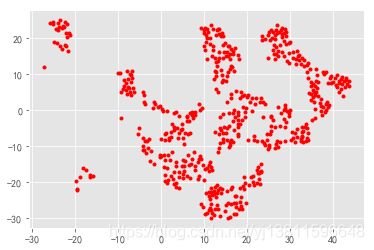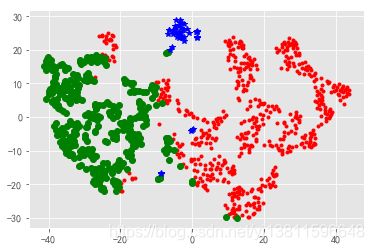第一个:
import numpy as np
import matplotlib.pyplot as plt
from sklearn import manifold, datasets
digits = datasets.load_digits(n_class=6)
X, y = digits.data, digits.target
n_samples, n_features = X.shape
'''显示原始数据'''
n = 20
img = np.zeros((10 * n, 10 * n))
for i in range(n):
ix = 10 * i + 1
for j in range(n):
iy = 10 * j + 1
img[ix:ix + 8, iy:iy + 8] = X[i * n + j].reshape((8, 8))
plt.figure(figsize=(8, 8))
plt.imshow(img, cmap=plt.cm.binary)
plt.xticks([])
plt.yticks([])
plt.show()

type(X)
numpy.ndarray
X[0]
array([ 0., 0., 5., 13., 9., 1., 0., 0., 0., 0., 13., 15., 10.,
15., 5., 0., 0., 3., 15., 2., 0., 11., 8., 0., 0., 4.,
12., 0., 0., 8., 8., 0., 0., 5., 8., 0., 0., 9., 8.,
0., 0., 4., 11., 0., 1., 12., 7., 0., 0., 2., 14., 5.,
10., 12., 0., 0., 0., 0., 6., 13., 10., 0., 0., 0.])
X.size
69312
X.shape
(1083, 64)
print(n_samples, n_features)
1083 64
'''t-SNE'''
tsne = manifold.TSNE(n_components=2, init='pca', random_state=501)
X_tsne = tsne.fit_transform(X)
print("Org data dimension is {}.Embedded data dimension is {}".format(X.shape[-1], X_tsne.shape[-1]))
'''嵌入空间可视化'''
x_min, x_max = X_tsne.min(0), X_tsne.max(0)
X_norm = (X_tsne - x_min) / (x_max - x_min)
plt.figure(figsize=(8, 8))
for i in range(X_norm.shape[0]):
plt.text(X_norm[i, 0], X_norm[i, 1], str(y[i]), color=plt.cm.Set1(y[i]),
fontdict={'weight': 'bold', 'size': 20})
plt.xticks([])
plt.yticks([])
plt.show()
Org data dimension is 64.Embedded data dimension is 2

第二个:
import pandas as pd
inputfile = r'consumption_data.xls'
k = 3
iteration = 500
data = pd.read_excel(inputfile, index_col = 'Id')
data_zs = 1.0*(data - data.mean())/data.std()
type(data_zs)
pandas.core.frame.DataFrame
print(data_zs.index)
Int64Index([ 1, 2, 3, 4, 5, 6, 7, 8, 9, 10,
...
933, 934, 935, 936, 937, 938, 939, 940, 941, 942],
dtype='int64', name='Id', length=940)
print(data_zs.columns)
Index(['R', 'F', 'M'], dtype='object')
print(data_zs[0:3])
R F M
Id
1 0.764186 -0.493579 -1.158711
2 -1.024757 -0.630079 0.622527
3 -0.950217 0.871423 -0.341103
from sklearn.cluster import KMeans
model = KMeans(n_clusters = k, n_jobs = 4, max_iter = iteration)
model.fit(data_zs)
r1 = pd.Series(model.labels_).value_counts()
r1
0 559
1 341
2 40
dtype: int64
r2 = pd.DataFrame(model.cluster_centers_)
r2
|
0 |
1 |
2 |
| 0 |
-0.149353 |
-0.658893 |
-0.271780 |
| 1 |
-0.160451 |
1.114802 |
0.392844 |
| 2 |
3.455055 |
-0.295654 |
0.449123 |
r = pd.concat([r2, r1], axis = 1)
r
|
0 |
1 |
2 |
0 |
| 0 |
-0.149353 |
-0.658893 |
-0.271780 |
559 |
| 1 |
-0.160451 |
1.114802 |
0.392844 |
341 |
| 2 |
3.455055 |
-0.295654 |
0.449123 |
40 |
r.columns = list(data.columns) + [u'类别数目']
print(r)
R F M 类别数目
0 -0.149353 -0.658893 -0.271780 559
1 -0.160451 1.114802 0.392844 341
2 3.455055 -0.295654 0.449123 40
type(model)
sklearn.cluster.k_means_.KMeans
model[0]
---------------------------------------------------------------------------
TypeError Traceback (most recent call last)
in ()
----> 1 model[0]
TypeError: 'KMeans' object does not support indexing
type(model.labels_)
numpy.ndarray
model.labels_.size
940
model.cluster_centers_
array([[-0.14935336, -0.65889299, -0.27177977],
[-0.16045063, 1.11480154, 0.39284443],
[ 3.45505486, -0.29565357, 0.44912342]])
outputfile = 'data_type.xls'
r = pd.concat([data, pd.Series(model.labels_, index = data.index)], axis = 1)
r.columns = list(data.columns) + [u'聚类类别']
r.to_excel(outputfile)
data_out = pd.read_excel(outputfile, index_col = 'Id')
print(data_out[0:3])
R F M 聚类类别
Id
1 27 6 232.61 0
2 3 5 1507.11 0
3 4 16 817.62 1
from sklearn.manifold import TSNE
tsne = TSNE()
tsne.fit_transform(data_zs)
tsne = pd.DataFrame(tsne.embedding_, index = data_zs.index)
import matplotlib.pyplot as plt
plt.rcParams['font.sans-serif'] = ['SimHei']
plt.rcParams['axes.unicode_minus'] = False
d = tsne[r[u'聚类类别'] == 0]
plt.plot(d[0], d[1], 'r.')
d = tsne[r[u'聚类类别'] == 1]
plt.plot(d[0], d[1], 'go')
d = tsne[r[u'聚类类别'] == 2]
plt.plot(d[0], d[1], 'b*')
plt.show()

print(tsne[0:3])
0 1
Id
1 13.233582 22.531153
2 15.523943 -25.674824
3 -30.262331 11.098033
print(tsne.index.size)
940
r[0:3]
|
R |
F |
M |
聚类类别 |
| Id |
|
|
|
|
| 1 |
27 |
6 |
232.61 |
0 |
| 2 |
3 |
5 |
1507.11 |
0 |
| 3 |
4 |
16 |
817.62 |
1 |
d = tsne[r[u'聚类类别'] == 0]
d[0:3]
|
0 |
1 |
| Id |
|
|
| 1 |
13.233582 |
22.531153 |
| 2 |
15.523943 |
-25.674824 |
| 4 |
-24.099859 |
24.144758 |
d.index.size
559
plt.plot(d[0], d[1], 'r.')
[]

d1 = tsne[r[u'聚类类别'] == 1]
plt.plot(d1[0], d1[1], 'go')
[]

d = tsne[r[u'聚类类别'] == 0]
plt.plot(d[0], d[1], 'r.')
d = tsne[r[u'聚类类别'] == 1]
plt.plot(d[0], d[1], 'go')
d = tsne[r[u'聚类类别'] == 2]
plt.plot(d[0], d[1], 'b*')
plt.show()

第二个例子来源于,张良均等著《python数据分析与挖掘实战》





